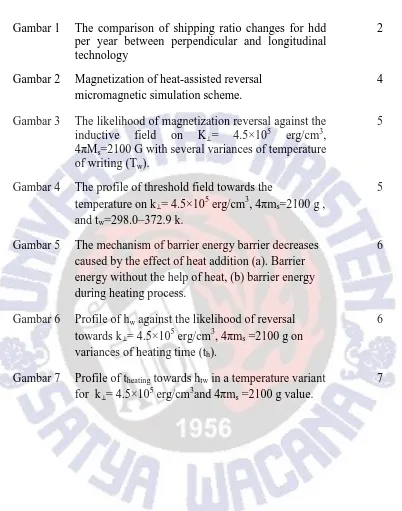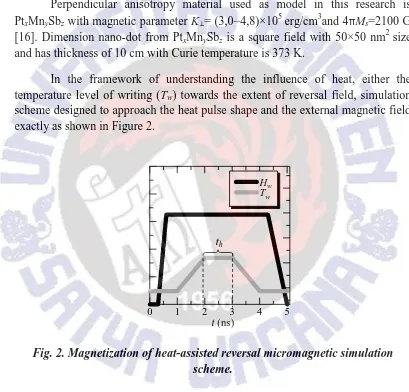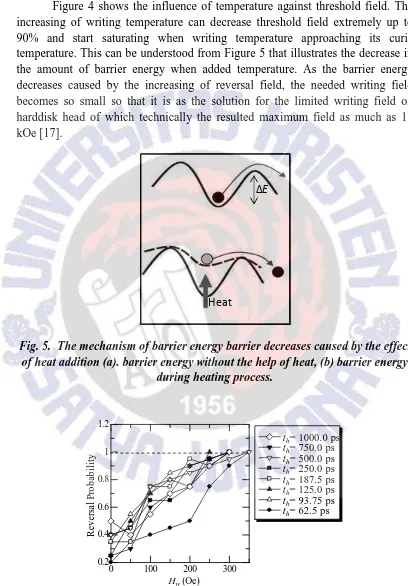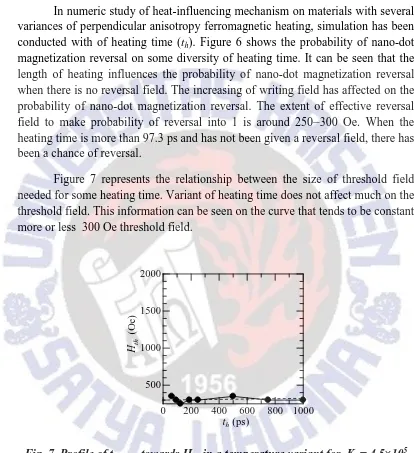i
HEATING MODE EFFECT ON PERPENDICULAR MAGNETIC RECORDING
Oleh,
Rivaldo Mersis Brilianto NIM: 192009020
TUGAS AKHIR
Diajukan kepada Program Studi Pendidikan Fisika,Fakultas Sains dan Matematika guna memenuhi sebagian dari persyaratan untuk memperoleh
gelar Sarjana Pendidikan
Program Studi Pendidikan Fisika
FAKULTAS SAINS DAN MATEMATIKA UNIVERSITAS KRISTEN SATYA WACANA
v
MOTTO
Rendah Hati 1 Petrus 5:5-6
5
Demikian jugalah kamu hai orang-orang muda, tunduklah kepada orang-orang yang tua. Dan kamu semua, rendahkanlah dirimu seorang terhadap yang lain, sebab: “ Allah menentang orang yang congkak, tetapi mengasihani orang yang rendah hati.” 6Karena itu rendahkanlah dirimu di bawah tangan Tuhan yang kuat, supaya kamu ditinggikan-Nya pada waktunya.
1 Petrus 5:5-6 Firman Tuhan
Kolose 3:16
Hendaklah perkataan Kristus diam dengan segala kekayaannya di antara kamu, sehingga kamu dengan segala hikmat mengajar dan menegur seorang akan yang lain dan sambil menyanyikan mazmur, dan puji-pujian dan nyanyian rohani, kamu mengucap syukur kepada Allah di dalam hatimu.
Kolose 3:16 Jaminan Kemenangan
1 Korintus 10:13
Pencobaan-pencobaan yang kamu alami adalah pencobaan biasa, yang tidak melebihi kemampuan manusia. Sebab Allah setia dan karena itu Ia tidak akan membiarkan kamu dicobai melampaui kekuatanmu. Pada waktu kamu dicobai, Ia akan memberikan kepadamu jalan ke luar, sehingga kamu dapat menanggungnya. 1 Korintus 10:13
vi
Kata Pengantar
Puji dan syukur penulis panjatkan kepada Sang Mesias Tuhan Yesus Kristus karena penulis menyadari bahwa hanya karena kasih karunia-Nya saja penulis dapat menyelesaikan tugas akhir ini dengan baik.
Penyusunan Tugas Akhir ini tidak dapat terlepas dari bantuan dan kerjasama dari berbagai pihak. Oleh karena itu, penulis mengucapkan terima kasih kepada: 1. Nur Aji Wibowo, S.Si., M.Si., selaku pembimbing I, terima kasih atas
dukungan semangat, kesabaran, teladan dalam menulis dan bersikap sebagai ilmuan dan pembimbing yang baik. Banyak ilmu dan pengalaman yang bisa saya terima dari beliau dan saya yakin akan berguna bagi masa depan karir saya.
2. Andreas Setiawan, S.Si., MT selaku Dosen Pembimbing II yang bersedia memberikan waktu, pengertian, penghiburan dengan candaannya, serta teladan menjadi seorang dosen yang mampu menjadi sahabat bagi mahasiswanya.
3. Keluargaku yang tersayang Papa dan mamah yang telah memberikan kesempatan bagi penulis hingga dapat menyelesaikan kuliah. Adik-adikku Edgar, Vega dan Veren Terima kasih atas doa. Terima kasih pula atas kekeluargaan yang hangat dan ceria sehingga memberi kesegaran saat jiwa dilanda kepenatan.
4. Kim Sung Min sebagai ayah rohani dan pemimpin saya yang selalu menolong penulis secara pribadi serta Min Suk dan sekeluarga yang telah mendoakan saya untuk menyelesaikan studi. Teman-teman persekutuan yang sangat menolong penulis bertumbuh dan mendewasakan rohani (Rendra, Tri Nova, S.Si.,M.Si , Meyhart, Aldi, S.SI, Tesar, Min Seong, Arfael, dan teman-teman putri).
vii
Wibowo, S.Si., M.Si, Bapak Wahyu Hari Kristiyanto S.Pd., M.Pd), terima kasih atas bekal ilmu pengetahuan yang telah diberikan kepada penulis. 6. Bebek (Eka) yang telah menemani dan mendukung penulis dalam doa,
tempat berbagi pergumulan, dan tentunya semangat menyelesaikan tugas akhir ini. Ginanjar dan Koko sebagai sahabat yang tak akan pernah penulis lupakan, serta mahasiswa Fakultas Sains dan Matematika angkatan 2009 yang telah menjadi rekan kerja, dan teman setia selama masa-masa perkuliahan. Terima kasih atas kebersamaannya.
7. Laboran Fisika UKSW (Mas Sigit dan Mas Tri). Terimakasih atas segala bantuan yang telah diberikan selama penulis berkuliah. Maaf jika selalu merepotkan dengan berbagai peralatan yang harus disiapkan saat praktikum. 8. Pihak-pihak lain yang tidak dapat dituliskan namanya satu persatu yang
turut terlibat dalam penulisan skripsi ini
Penulis menyadari bahwa masih banyak kekurangan dalam penulisan dan penyelesain skripsi ini. Untuk itu, penulis mengharapkan kritik dan saran yang bersifat membangun untuk hasil yang lebih baik lagi di masa yang akan datang. Apabila dalam penyusunan skripsi ini ada kata-kata yang kurang berkenan di hati pembaca, penulis mohon maaf. Akhirnya semoga tulisan ini bermanfaat dan menjadi berkat bagi pembaca khususnya bagi pihak-pihak yang berkepentingan.
Salatiga, 3 Februari 2014
Penulis
viii DAFTAR ISI
HALAMAN JUDUL i
LEMBAR PENGESAHAN ii
LEMBAR PERNYATAAN KEASLIAN iii
LEMBAR HAK BEBAS ROYALTI DAN PUBLIKASI iv
LEMBAR MOTTO v
KATA PENGANTAR vi
DAFTAR ISI viii
DAFTAR GAMBAR ix
ABSTRAK 1
PENDAHULUAN 1
METODA 3
HASIL DAN PEMBAHASAN 5
KESIMPULAN 7
DAFTAR PUSTAKA 8
LAMPIRAN 10
ix
Daftar Gambar
Gambar 1 The comparison of shipping ratio changes for hdd per year between perpendicular and longitudinal technology
2
Gambar 2 Magnetization of heat-assisted reversal micromagnetic simulation scheme.
4
Gambar 3 The likelihood of magnetization reversal against the inductive field on K⊥= 4.5×105 erg/cm3, 4πMs=2100 G with several variances of temperature
of writing (Tw).
5
Gambar 4 The profile of threshold field towards the
temperature on k⊥= 4.5×105 erg/cm3, 4πms=2100 g ,
and tw=298.0−372.9 k.
5
Gambar 5 The mechanism of barrier energy barrier decreases caused by the effect of heat addition (a). Barrier energy without the help of heat, (b) barrier energy during heating process.
6
Gambar 6 Profile of hw against the likelihood of reversal
towards k⊥= 4.5×105 erg/cm3, 4πms =2100 g on
variances of heating time (th).
6
Gambar 7 Profile of theating towards htw in a temperature variant
for k⊥= 4.5×105 erg/cm3and 4πms =2100 g value.
1
Heating Mode Effect on Perpendicular Magnetic Recording
Rivaldo M B1, Andreas Setiawan2, Nur Aji Wibowo2
1-3
Physics Department, Satya Wacana Christian University
Salatiga, Central Java, Indonesia
ABSTRACT: Has been conducted the micromagnetic simulation study on the
perpendicular material ferromagnetic PtxMnySbz by completing Landau-Lifshift
Gilbert equation. Choosen ferromagnetic material has some parameters such as anisotropy constant as large as 4.5×105 erg/cm3, magnetic saturation of 2100 G, Curie temperature of 373 K, and finite-dimension of 50×50×10 nm3. The use of perpendicular anisotropy media with appropriate properties value are intended to increase the storage capacity of the hard disk without ignoring its thermal stabilty. At writing information, ferromagnetic material is induced by magnetic field for reversing the direction of magnetization and all at once also heated by thermal pulse which was designed matches closely the reality. To examine thermal fluctuation effects, twenty random number for magnetization was adopted in calculation and probability of magnetization reversal was introduced for determining the theshold field. Evaluation of reversal mechanism has been done for the variations of temperature of 299.0−372.9 K. Heating exceeds 368.0 K capable to lowering the threshold field up to 90 % through the declining of energy barrier. Investigation also has done for some heating interval i.e. 62.5-1000.0 ps on the temperature which approaches to Curie temperature. As a result, in a span of heating were yielded that reversal field required for reversing the direction of magnetization is only about 250−300 Oe.
KEYWORDS: HAMR, perpendicular magnetic anisotropy, magnetization,
threshold field, reversal probability, threshold field.
1 INTRODUCTION
2
Fig. 1. The comparison of shipping ratio changes for HDD per year between perpendicular and longitudinal technology
The storage capacity is determined from how small unit cell needed to store a bit of information. It means that the size of storage media should be reduced to nano size to realize a hard disk with a bigger capacity. But when the size of memory cell units are reduced into nano order, it result problem on thermal stability [3], that is the magnetization tendency to change direction spontaneously even in room temperature, thus hindering the data recording process. To tackle this problem, it needs Perpendicular Magnetic Anisotropy (PMA) that has a large magnetic anisotropy so that the magnetization bearing will be more stable even though in room temperature [4]. As it grows, 2006 has become a new era for industry of Perpendicular Magnetic Recording (PMR) that using PMA as storage media [5]. The use of this technology gives hope to bring in the storage media with capacity in Tbit/in2 level [6], [7].
However, the use of PMA as a recording media with PMR technology still remains a critical issue, namely the need for a large current field in an attempt of PMA magnetization reversal as a result of the strong magnetic anisotropy materials [8]. One promising solution to solve the problem is by adding heat in the process of reversal magnetization then cooled rapidly to "freeze" the written information or called as Heat Assisted Magnetization Reversal (HAMR) [9], [10]. The process of writing data on TAMR technology uses laser to help raise the temperature of the media to a certain temperature [11].
3
temperature and duration of the heating towards the required field reversal with micromagnetic simulator.
2 METHODOLOGY
Magnetization reversal behavior on the perpendicular anisotropy nano-dot magnetic materials is investigated by solving the equation of Landau-Lifshiftz Gilbert [12]:
with M as the magnetization vector, Ms as the saturation of magnetization, α is the constant of gilbert muffle (0.3), is the γ gyromagnetic ratio as much as 1,76×107 oe-1.s-1 and Heff is the effective field. On Equation (2), Heff is the vector resultant of anisotropy field (Hk), magneto-static field (HM), interaction exchange field (Hex), external field (Hext), and stochastic random field (HT) [13].
= + + + +
eff k M ex ext T
H H H H H H (2)
The influence of temperature towards the constant behavior can be formulated in Equation (3) [14].
( )
sConsecutively, the dependency of magnetization and anisotropy constant on temperature related to magnetization changes is expressed as follows [15]:
( )
= 0 1− temperature. The total fluctuation field with zero temperature and assumed in Gaussian distribution with amplitude expressed through dissipation-fluctuation theorem just as seen on Equation (6-8) [15].( ) =0
i T
4
difference (0.25×10-12s),and V is the volume of nano-dot.
Perpendicular anisotropy material used as model in this research is PtxMnySbz with magnetic parameter K⊥= (3,0−4,8)×105 erg/cm3and 4πMs=2100 G [16]. Dimension nano-dot from PtxMnySbz is a square field with 50×50 nm2 size and has thickness of 10 cm with Curie temperature is 373 K.
In the framework of understanding the influence of heat, either the temperature level of writing (Tw) towards the extent of reversal field, simulation scheme designed to approach the heat pulse shape and the external magnetic field exactly as shown in Figure 2.
Fig. 2. Magnetization of heat-assisted reversal micromagnetic simulation scheme.
As for evaluating the influence of fluctuations due to temperature, the inverter field was calculated for 20 different series of random numbers. The minimum so that the inverter field reversal of opportunities to 20 the number of 1 are known as threshold field (Hth), which can be associated with the reversal field.
0 1 2 3 4 5
t (ns)
Hw
Tw
5
3 RESULT AND DISCUSSION
REVERSAL MAGNETIZATION ON HIGH TEMPERATURE
Fig. 3. The likelihood of magnetization reversal against the inductive field on K⊥⊥⊥⊥= 4.5×105 erg/cm3, 4πMs=2100 G with several variances of
temperature of writing (Tw).
Figure 3 shows the nano-dot magnetization reversal probability from PtxMnySbz. The increasing of temperature level of writing will add the nano-dot magnetization reversal probability. When the temperature at below 385 K where the field of writing has not been given, there are no likelihood of nano-dot magnetization reversal and this probability appears when the temperature of writing approaches curie temperature. This indicates an increase in writing temperature also affects on the increasing of magnetization reversal probability even with no help from external field.
6
Fig. 4. The profile of threshold field towards the temperature on K⊥⊥⊥⊥= 4.5×105 erg/cm3, 4πMs=2100 G , and Tw=298.0−372.9 K.
Figure 4 shows the influence of temperature against threshold field. The increasing of writing temperature can decrease threshold field extremely up to 90% and start saturating when writing temperature approaching its curie temperature. This can be understood from Figure 5 that illustrates the decrease in the amount of barrier energy when added temperature. As the barrier energy decreases caused by the increasing of reversal field, the needed writing field becomes so small so that it is as the solution for the limited writing field on harddisk head of which technically the resulted maximum field as much as 17 kOe [17].
Fig. 5. The mechanism of barrier energy barrier decreases caused by the effect of heat addition (a). barrier energy without the help of heat, (b) barrier energy
7
Fig. 6. Profile of Hw against the likelihood of reversal towards K⊥⊥⊥⊥= 4.5×105 erg/cm3, 4πMs =2100 G on variances of heating time (th).
In numeric study of heat-influencing mechanism on materials with several variances of perpendicular anisotropy ferromagnetic heating, simulation has been conducted with of heating time (th). Figure 6 shows the probability of nano-dot magnetization reversal on some diversity of heating time. It can be seen that the length of heating influences the probability of nano-dot magnetization reversal when there is no reversal field. The increasing of writing field has affected on the probability of nano-dot magnetization reversal. The extent of effective reversal field to make probability of reversal into 1 is around 250−300 Oe. When the heating time is more than 97.3 ps and has not been given a reversal field, there has been a chance of reversal.
Figure 7 represents the relationship between the size of threshold field needed for some heating time. Variant of heating time does not affect much on the threshold field. This information can be seen on the curve that tends to be constant more or less 300 Oe threshold field.
Fig. 7. Profile of theating towards Htw in a temperature variant for K⊥⊥⊥⊥= 4.5×105 erg/cm3and 4πMs =2100 G value.
4 CONCLUSION
8
magnetization reversal in ferromagnetic materials with perpendicular anisotropy for the value of K⊥= 4.5×105 erg/cm3 and 4πMs =2100 G on curie
temperature heat-up to range of heating 62.5−1000.0 ps effectively capable of lowering the field author until the range 300 Oe or 500% under the maximum field which is capable of being produced by the hard disk head writer at this time.
REFERENCES
[1] Yiming Wang, Physics and Micromagnetic Analysis of Advanced Recording
Technologies, Doctoral Dissertation, Pennsylvania: Carnegie Mellon
University Pittsburgh, 2012.
[2] Shunichi Iwasak, “Past and Present of Perpendicular Magnetic Recording”,
Journal of Magnetism and Magnetic Materials, 320, 2845–2849, 2008.
[3] Piramanayagam S.N. dan Srinivasan K, “Recording Media Research for Future Hard Disk Drives”, Journal of Magnetism and Magnetic Materials, 321, 485–494, 2009.
[4] Koji Matsumoto, Akhihiro Inomata, and Shin-ya Hasigawa, “Thermally Asssisted Magnetic Recording”, FUJITSU Sci,Tech,J, vol. 42, pp. 158, 2006. [5] Wood R., Hsu Y., and Schultz M, Perpendicular Magnetic Recording
Technology, Hitachi Global Storage Technologies, USA: Whitepaper HGST,
2007.
[6] Felipe Garcίa Sánchez, Modeling of Field and Thermal Magnetization Reversal in Nanostructured Magnetic Materials, Doctoral Dissertation,
Madrid : Dpto de Fίsίca Teόrica de la Materia Condensada, Universidad
Autόnoma de Madrid, 2007.
[7] Ostler T.A., Barker J., et al, ”Ultrafast Heating as a Sufficient Stimulus for Magnetization Reversal in a Ferrimagnet”, Nature Communications, 9, 666, 2012
[8] Nur Aji Wibowo, ”Micromagnetic Study of Switching Mode Behavior on Perpendicularly Magnetized Nano-Dot at a Room Temperature“,
International Journal of Computer Technology and Electronics Engineering,
vol. 2, Issue 3, 2012
[9] Nur Aji Wibowo, ”Heat Assisted Magnetization Reversal on Perpendicular Magnetized Nano-Dot”, The Journal for Technology and Science, vol 22, no 2, 2011.
[10] Challenger W.A. , Chubing Peng, Itagi A.V. , D.Karns, et al, ”Heat-Assisted Magnetic Recording by a Near-Field Transducer with Efficient Optical Energy Transfer”, Nature Photonics, vol. 3, 2009.
9
[12] Hweerin Sohn, “Micromagnetic Analysis of Magnetic Nanoparticles for Hyperthermia Cancer Treatment and of Transition Characteristics for Recording Media”, USA: University of Minnesota, 2012.
[13] Wahyu Natalis Handayani, Andreas Setiawan, and Nur Aji Wibowo, “Gilbert Damping Effect on Thermally Assisted Magnetization Reversal of Perpendicular Magnetize Nano-Dot”, International Journal of Science and
Enginering Investigations, Vol.2, issue 16 , 2013.
[14] Purnama B., Koga M., Nozaki Y and Matsuyama K, “Stochastic Simulation of Thermally Assisted Magnetization Reversal in Sub-100nm Dots with Perpendicular Anisotropy”, Journal of Magnetism and Magnetic Materials. 321. 1325-1330, 2009.
[15] Agustina Candra D.P., Suryasatriya Trihandaru, and Nur Aji Wibowo, ”Micro Magnetic Study of Thermally Assisted Magnetization Reversal Mechanism on Perpendicularly Magnetic Anisotropy CoxSIyBz”. International Journal of Science and Research, vol.2, issue 5 , 2013.
[16] Kawanabe T, and Naoe M, “Annealing Effect on Magnetic Charateristicis of Pt/MnSb Multilayered Films”, Journal de Physique, Tome 49, 1988.




